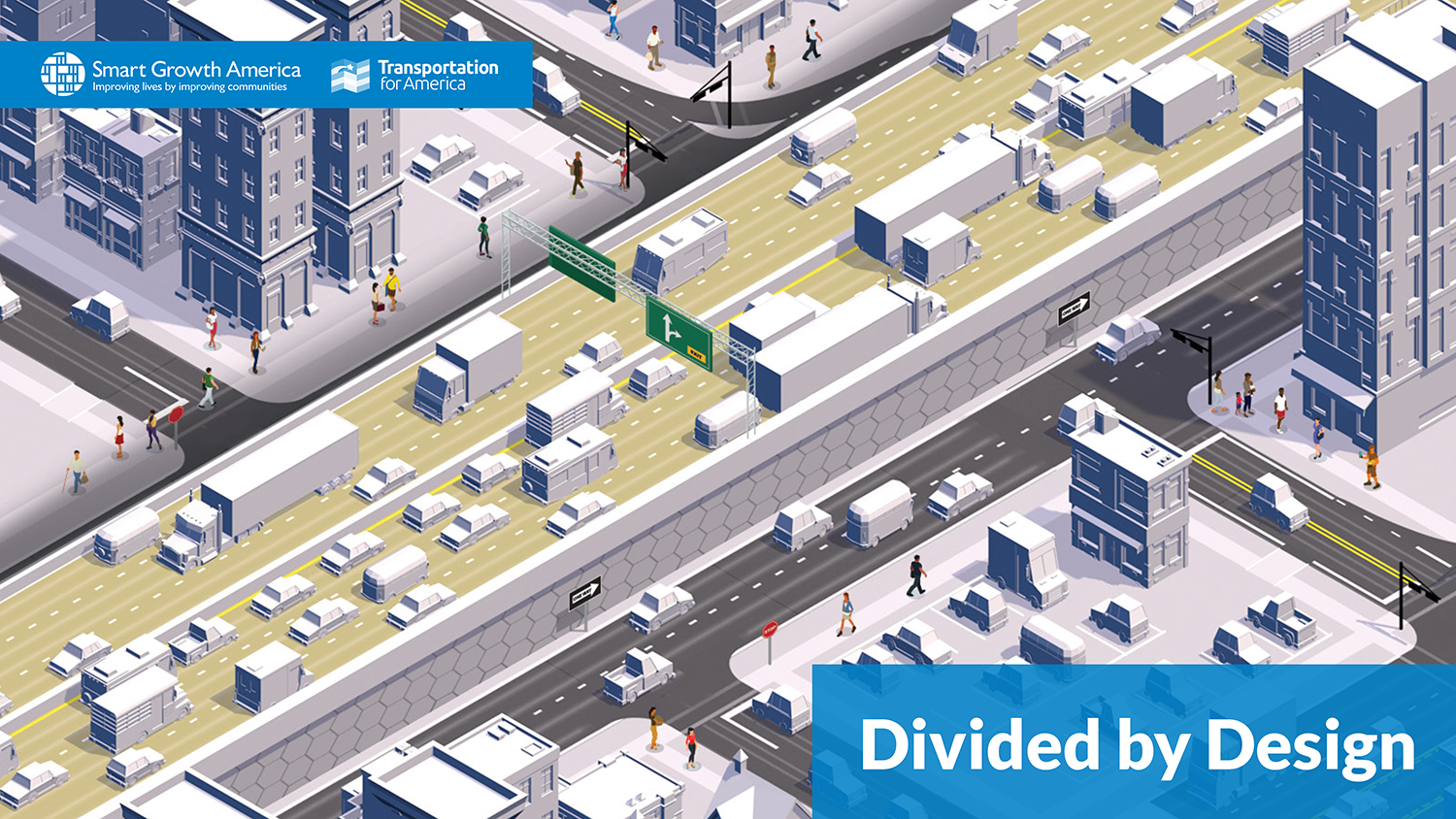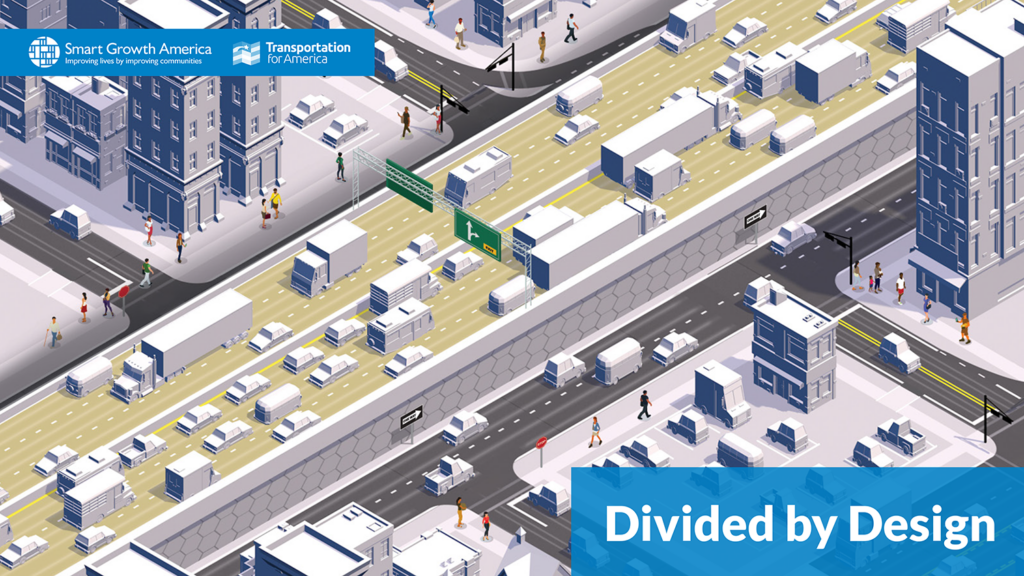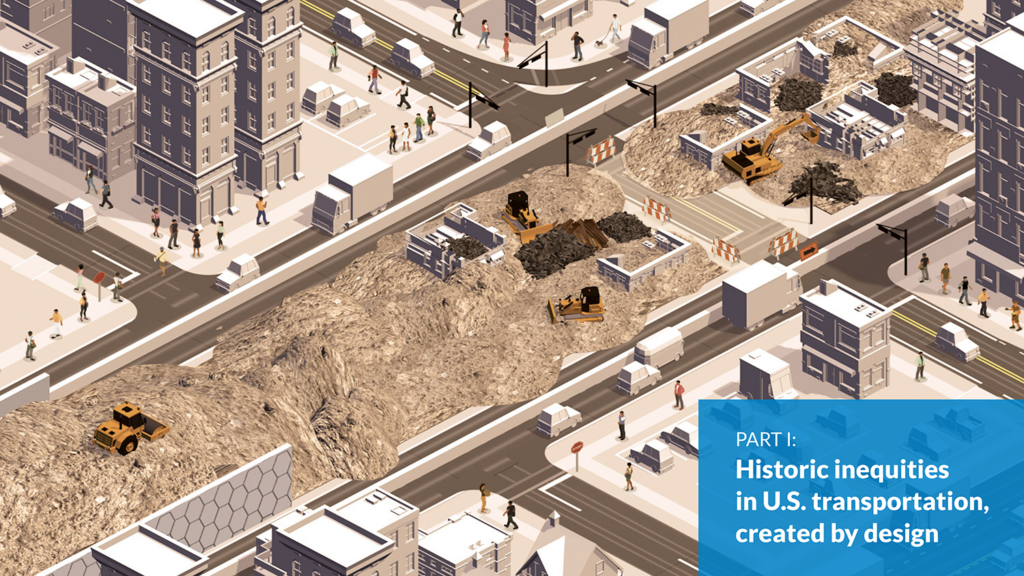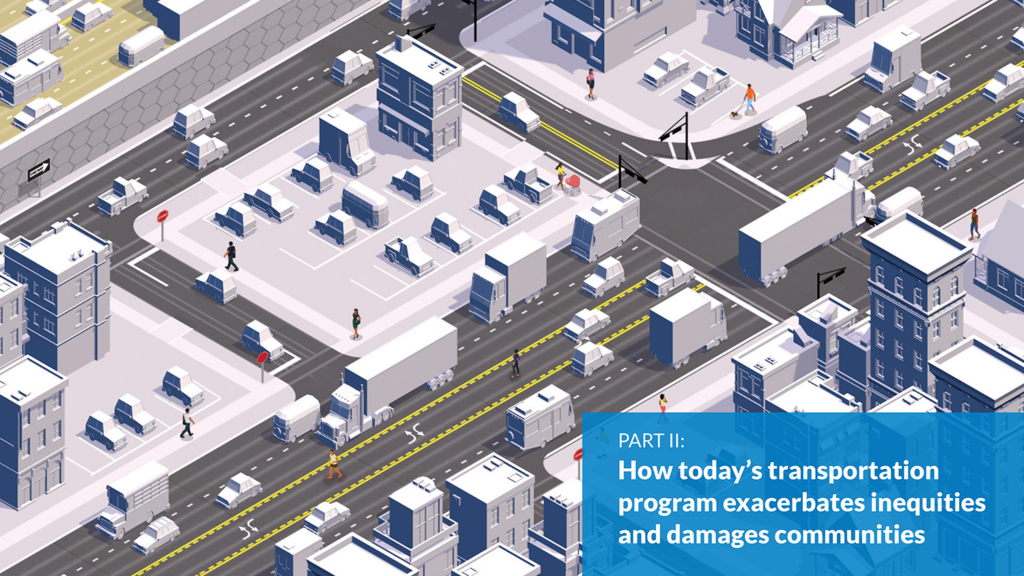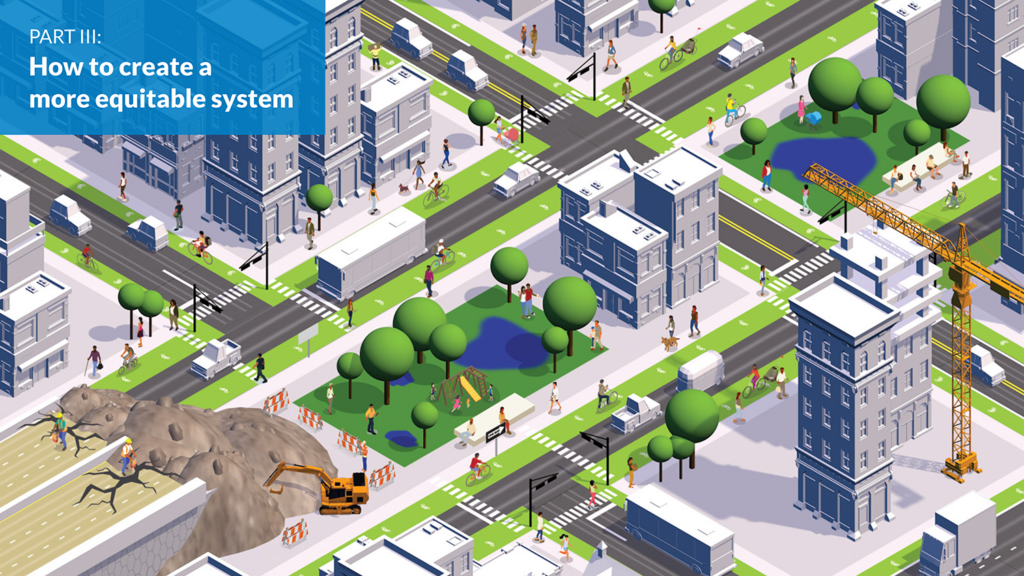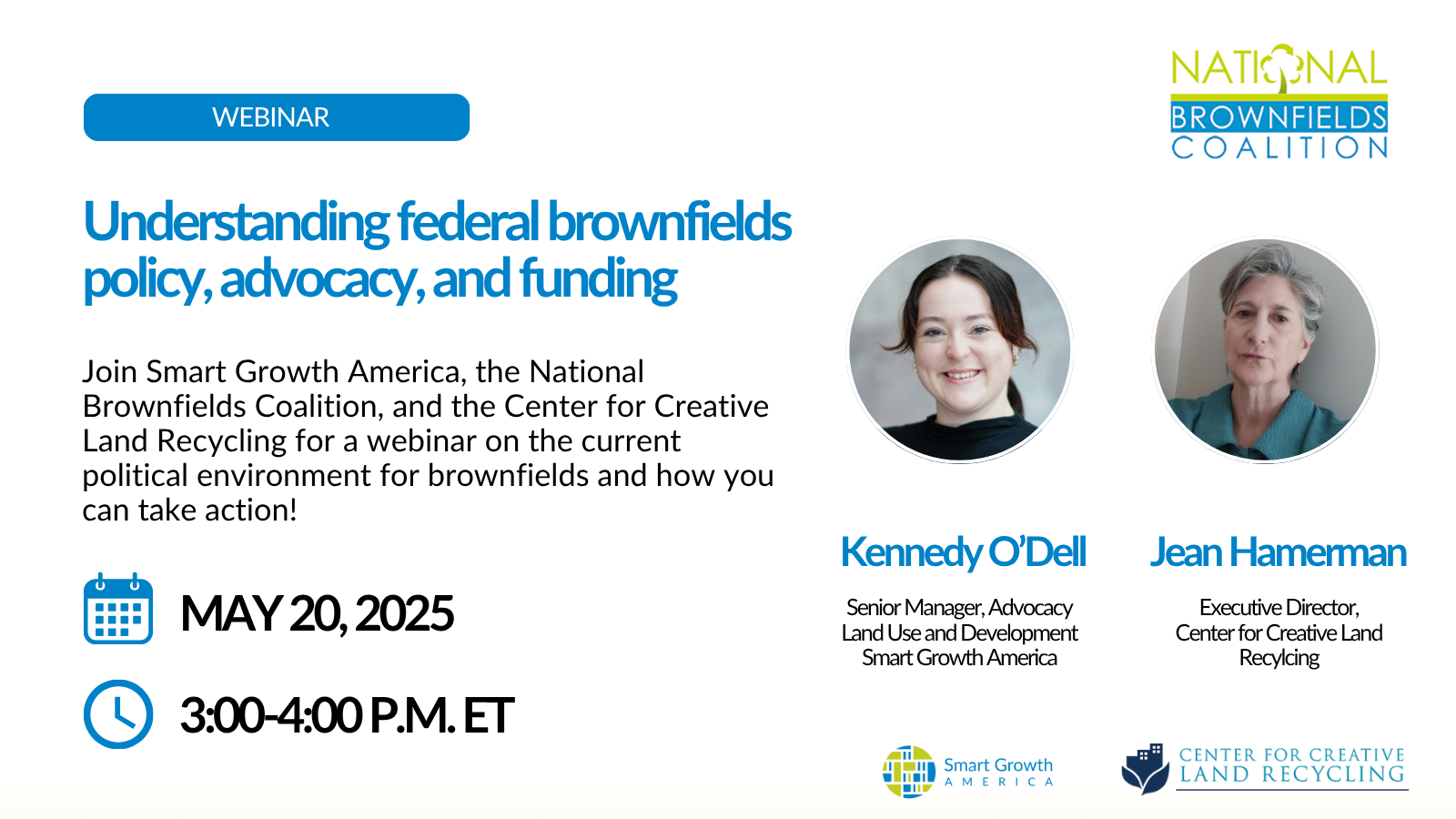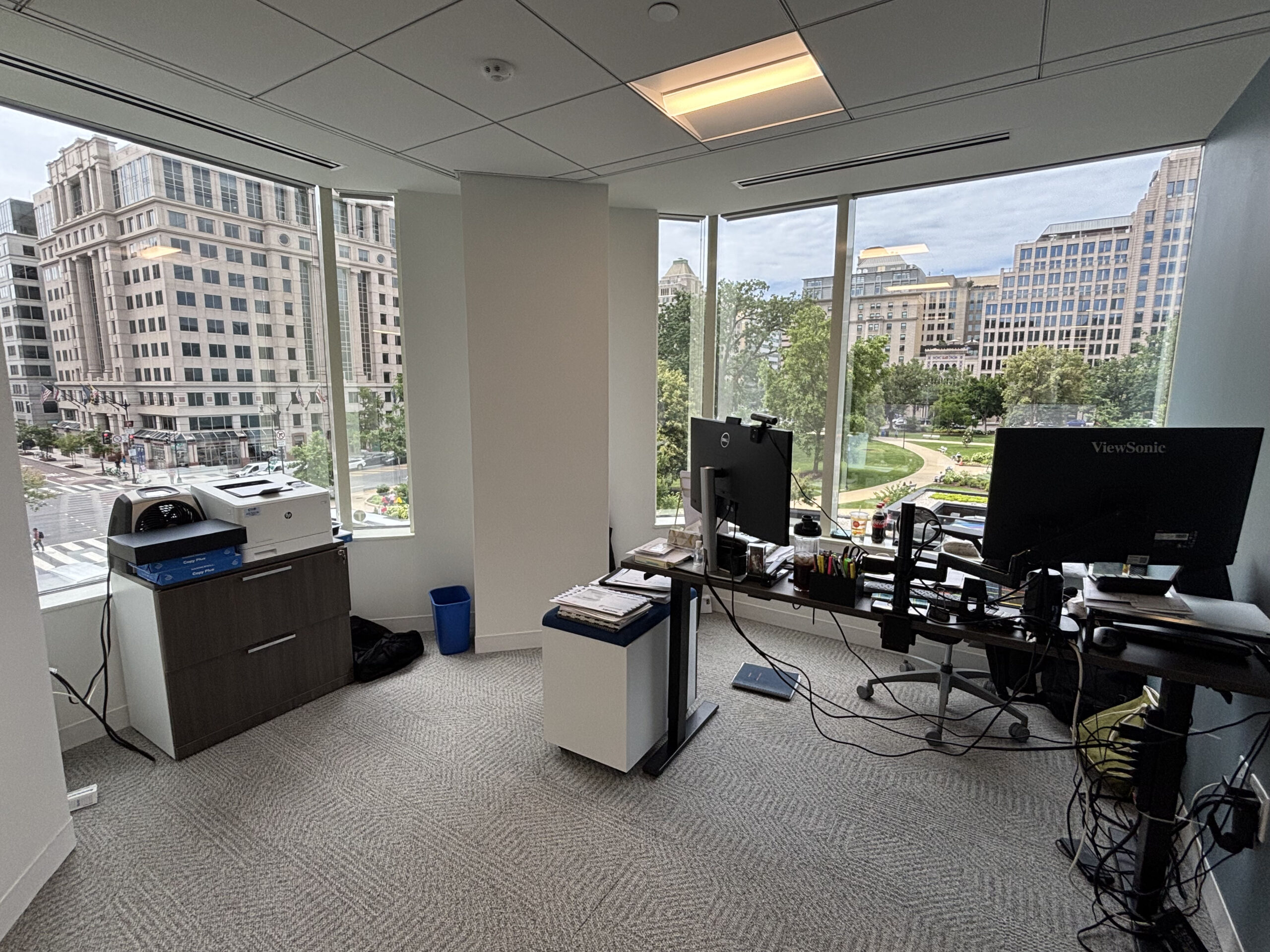Divided by Design
Divided by Design
Low-income communities and communities of color have been and continue to be disproportionately harmed by our approach to transportation in the United States.
This damage has come in many forms, but most egregiously through the construction of the Interstate Highway System. A growing understanding of this reality helped lead to the creation of new provisions and programs aimed at undoing some of this damage in the November 2021 infrastructure bill. But these steps were modest and policy interventions continue to focus largely on past harms or making small, insufficient reforms. All of which ultimately fails to grapple with the reality that the fundamental approach of our current transportation program creates and exacerbates inequities.
Past decisions, including routing the Interstate Highway System through communities of color, dividing and often demolishing them in the process, still shape our built environment. And most importantly, the foundation of the modern transportation program was built on models, measures, and standards with roots in this era.
Without a fundamental change to the overall approach to transportation, today’s leaders and transportation professionals, no matter their intent, will perpetuate and exacerbate the damage.
A guide to this report
After a brief introduction below, Part I examines the damage and inequities deliberately created by and in the federal transportation program from ~1950 onward. It concludes with a unique analysis of both an unbuilt and built highway segment within Atlanta and Washington, DC to quantify what was lost, who bore the brunt of the damage, and what could have been lost with highways that were never built.
Part II examines our current transportation program to demonstrate how the programs, standards, models, and measures have their roots in the previous era and exacerbate inequities—whether intentional or not.
Part III outlines what needs to change—concrete steps we can take to fundamentally reorient the program around unwinding those inequities.
This video, drawn from content in Part II, explains how modern federal guidance on estimating the value of time helps justify the hefty price tag of destructive, divisive highway projects.
The divisions aren’t felt equally
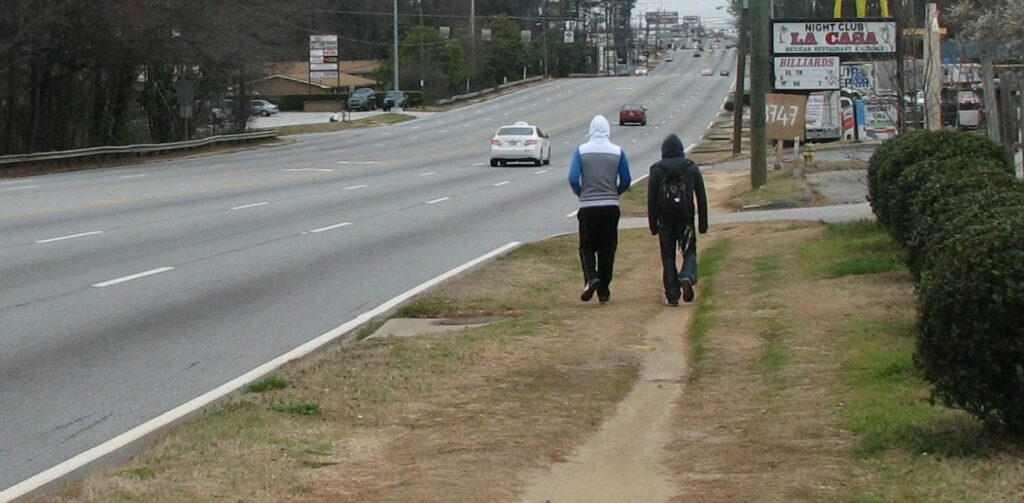
Because it is difficult and unsafe to reach daily needs without a vehicle in much of the United States, transportation has long acted as an economic barrier in the United States. Owning a car has become a prerequisite for accessing jobs, food, health care, and other necessities. Homes are located far from major job centers, services, and stores, requiring multiple car trips daily to reach essential needs.
This spread-out, sprawling form of development makes public transportation inefficient to operate, producing infrequent, inconvenient, and unreliable service. Fewer than 10 percent of Americans currently live within walking distance of frequent transit, like buses or metro trains. Even in areas where homes, stores, and medical care are geographically close, car-oriented infrastructure and development can make it difficult, and even deadly, to travel between destinations without a vehicle. Wide, heavily trafficked roads with subpar or non-existent sidewalks and few places to cross safely make walking or biking unpleasant at best and deadly at worst. For people with impaired vision, mobility, or cognitive ability, navigating these communities can be impossible.
These two systems reinforce each other: sprawling development requires wider roads to move people, almost all of whom have to drive between spread-out destinations; and wide, fast roads require so much space to move and store the cars that development is forced to sprawl even further apart. The result is both predictable and expensive: necessities move further away and reaching them costs more in terms of money and time.
Approximately 28 million Americans (about nine percent of the population) do not have access to a car, and lower-income people and people of color are more likely to not have access to a car. This is not just an urban issue. In fact, the majority of counties in the U.S. with high rates of zero-car households are rural. And too often policymakers dismiss the transportation needs of rural Americans by assuming that everyone has cars and is happy to spend vast amounts of their time and money on driving.
We can and must do better.
Merely making tweaks to our approach will fail to correct fundamental problems
Our approach to transportation needs a massive shift: from primarily focusing on the movement of vehicles, to instead focusing on connecting people to the things they need, no matter who they are, where they live, or how they travel.
The widely accepted approach to addressing the destructive flaws in our transportation system has been the same for years now: make small, additive reforms, while failing to change the underlying program, standards, or practices. On the project level, this is akin to adding a bike lane and sidewalk along a dangerous road that is never changed.
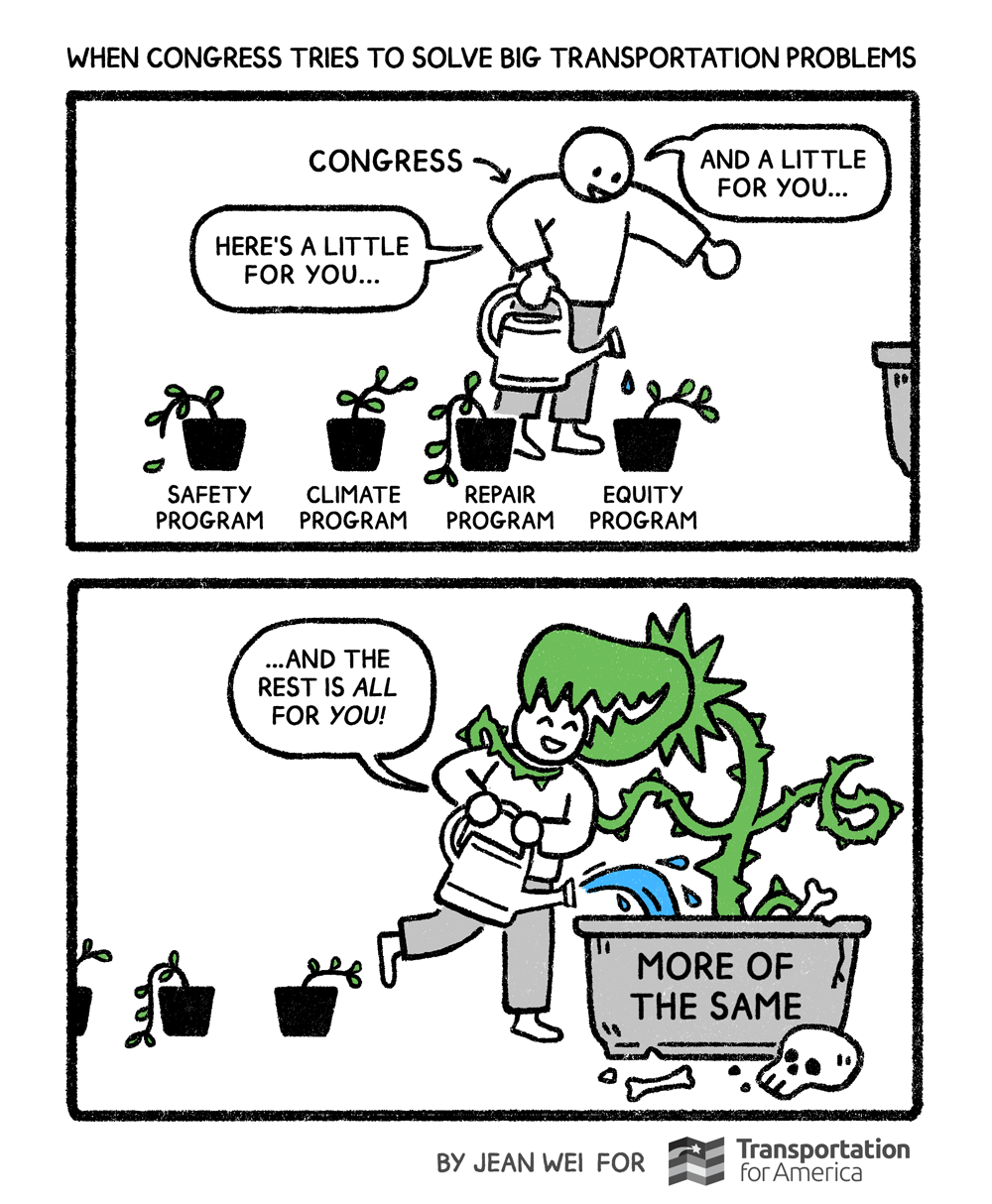
On the program level, it’s done by routinely creating small new programs to improve problems that are being actively reinforced by the billions contained in the conventional federal transportation program.1
For example, the Reconnecting Communities Program, a competitive grant program funded at $1 billion over five years in the 2021 infrastructure law, was explicitly touted as a source of funding for projects that aim to remove or address divisive infrastructure. Not only is that a pittance compared to the rest of the program, but the full infrastructure law also allows a great deal of flexibility for state DOTs and localities to move forward on projects that would further divisions or create new divides.
Small, niche, siloed efforts (like these) cannot repair past damage or keep up with the new barriers being created by new projects. To create a system that serves everyone and halts the practice of benefiting certain people at the expense of others, we need a new set of governing principles, standards, models, and measures, embedded in every single project and program.
While the federal government has direct control over only a small amount of discretionary funding, they do control roadway design standards, models and tools, and performance targets that states rely on every single day.
States, which control the lion’s share of all transportation dollars, have immense flexibility to try something new that might get better results. The question now is whether elected leaders at the state and federal level will settle for more of the same or demand that USDOT and state DOTs reorient the transportation program to provide all people access to jobs and services no matter their location, financial means, or physical ability.
If our elected, appointed, and civil transportation decision-makers fail to understand how current USDOT guidance and state DOT actions are still actively harming low-income people, people of color, older people, and people with disabilities, they cannot begin to truly rectify these injustices. (As spelled out in Part II)
Their intent to do things differently or better than their publicly racist forebears in the 1950s and 1960s is irrelevant when many of those previous practices are still deeply embedded in the transportation policies and standards of today. Today’s leaders must understand how the past is still shaping current practices. They must reevaluate how their decisions are made and who their decisions serve.
Congress and the federal government are right in part: it is time to fix the harms of our transportation system, but creating tiny new programs will fail to address the damage.
We need a new approach.
Read the rest of Divided by Design
Explore the report’s full content using the sidebar menu at right (or below if on a mobile device), or jump to one of the three parts with the graphics below.
Don’t miss supplemental maps, videos, and animations in the DC and Atlanta case studies which are not in the hard copy. Download a PDF version of the report.
The final word
Simply putting new people with better intentions at the helm of our transportation apparatus has failed to repair past mistakes or stop producing the same old inequalities. While they often use more enlightened language, little in the program has fundamentally changed so the outcomes haven’t changed much either.
It’s sobering to read about our sordid history of transportation planning and investment in America in Part I. Learning that history is vital, and should be required reading for anyone involved in transportation today. But we can’t stop there. We must also understand how our actions today still cause harm, especially to low income and Black and Brown communities.
We’re sympathetic to the many well- intentioned policymakers, transportation planners, and engineers working today who find that history just as appalling and strive to depart from the practices of the past.
We understand that many who have their hands on the levers of control today are not intending the same results as their forebears, many of whom intentionally sought to harm, divide, and displace people solely because of the color of their skin or size of their wallets. But as Part II shows at length, good intent is not powerful enough to override a system that has institutionalized and internalized values that still prioritize certain people over others and one type of travel over everything else.
Using the same tools as decades past and hoping for different results is a losing battle. The end result is the same old outcomes of yesterday. At some point, tolerating the same results gives rise to culpability.
If we’re ever going to truly move past the disgraceful history of our highway program, we have to discard the systems of the past.
Systems created to separate and segregate cannot help us restore and renew. Models and measures designed to move vehicles above all else cannot be used to prioritize people and places. Our scales don’t need rebalancing, they need replacing,
The recommendations in Part III, while substantial, are not exhaustive. Countless other organizations and advocates have important ideas about what’s necessary to truly do away with our historic approach to transportation and build a new system from the ground up. But those four broad areas are a good place to start.
We hope that those on the inside, from members of Congress down to local transportation planners, will work together to create new tools and approaches to reconnect and restore what has been divided by design.
Recent posts from Smart Growth America
Four takeaways from the National Brownfields Coalition’s federal policy webinar
The National Brownfields Coalition and the Center for Creative Land Recycling (CCLR) hosted a webinar last week on understanding federal brownfields policy, advocacy, and funding in 2025. Attendees heard from Kennedy O’Dell, Senior Manager of Advocacy at Smart Growth America, and Jean Hamerman, Executive Director of CCLR, who explained the history of the brownfields program … Continued
Downtown Washington D.C. sub-lease opportunity
Background Smart Growth America (SGA) is seeking one to three mission-aligned organizations to share space within our high-quality office at 1350 I (“Eye”) Street NW, next to Franklin Square and the McPherson Square Metro station. SGA is a national non-profit organization advancing policy change in transportation and land use to create thriving, well-connected communities. SGA … Continued
